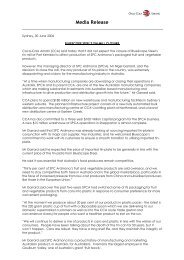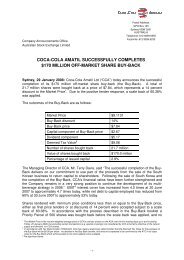2006 Sustainability Report - Coca-Cola Amatil
2006 Sustainability Report - Coca-Cola Amatil
2006 Sustainability Report - Coca-Cola Amatil
You also want an ePaper? Increase the reach of your titles
YUMPU automatically turns print PDFs into web optimized ePapers that Google loves.
Health and Safety<br />
Each country of operation now<br />
has a designated Occupational<br />
Health and Safety (OHS)<br />
representative responsible for<br />
improving OHS performance.<br />
Australia<br />
There has been significant<br />
improvement in OHS performance<br />
over the last few years. Our safety<br />
culture has strengthened and the<br />
OHS Management System (OHSMS)<br />
is increasingly embedded in operating<br />
practices. CCA Australia is targeting<br />
AS4801 accreditation by the end of 2008.<br />
A key to the improvement has<br />
been a strong commitment from<br />
the Australian Executive Team which<br />
reviews OHS performance monthly.<br />
CCA Australia has reduced injury rates,<br />
due to our focus in the following areas:<br />
• Implementing plans to reduce high<br />
risks areas such as cash handling<br />
(e.g. armed hold-up training),<br />
contractor management, forklift and<br />
traffic management plans, machine<br />
guarding and manual handling.<br />
• Implementing Corrective<br />
Action registers.<br />
• Training employees in their<br />
responsibilities and risk management<br />
processes in order to change the<br />
culture around OHS, and to make<br />
safety part of what we do everyday.<br />
SPC Ardmona<br />
SPCA has reduced its LTIFR by 50%<br />
over the last 3 years, thanks to a<br />
fundamental shift in focus to target<br />
workplace safety. Strategies included<br />
improved injury management<br />
techniques, training of Return to Work<br />
co-ordinators, more safety training, a<br />
pro-active rehabilitation program and<br />
the development of a workplace<br />
culture where all employees take<br />
responsibility for safety.<br />
Building on that recent success, the<br />
focus for SPCA in the next 12 months<br />
will be on the implementation of and<br />
compliance with the CCA Australia<br />
OHSMS. SPCA has also committed<br />
to the introduction of an Emergency<br />
Management System at its three sites.<br />
SPCA instituted a trial program with<br />
chiropractors from the Soft Tissue<br />
Centre to focus on Return to Work and<br />
management of long term injuries to<br />
reduce average time lost.<br />
New Zealand<br />
CCA launched a ‘10,000 Step<br />
Challenge’ which encouraged<br />
employees to walk 10,000 steps per<br />
day. Around 750 employees from a<br />
total employee base of just over 1,000<br />
participated. The promotion of a<br />
healthier lifestyle saw many benefits,<br />
in particular many of the participants<br />
lost significant amounts of weight.<br />
New Zealand also worked towards<br />
gaining ‘tertiary accreditation’ status<br />
with the Accident Compensation<br />
Corporation.<br />
Fiji<br />
CCA Fiji continues to implement<br />
its OHS management systems.<br />
Indonesia<br />
Each unit operation has now<br />
appointed a local OHS manager<br />
to implement initiatives which<br />
include an OHSMS, OHS reporting<br />
system, and the development of<br />
employees’safety awareness. More<br />
than 6,500 employees attended Safety<br />
Awareness training.<br />
All plants were audited by the<br />
Indonesian Government and received<br />
the highest award for OHS, the<br />
Golden Flag certificate.<br />
A new policy – No Helmet, No Entry –<br />
was introduced in June <strong>2006</strong>, whereby<br />
all CCA Indonesia employees who<br />
drive company motorbikes are<br />
required to wear a helmet at all times,<br />
and all employees, contractors and<br />
visitors entering company premises on<br />
a motorbike are also required to wear<br />
a helmet.<br />
South Korea<br />
OHS audits were conducted at all<br />
sites and actions put in place to<br />
improve OHS, which included:<br />
rear cameras installed on all trucks;<br />
implementation of methods to reduce<br />
lifting injuries; increased participation<br />
in OHS training programs; and<br />
implementation of improved<br />
personal protective equipment.<br />
23

















